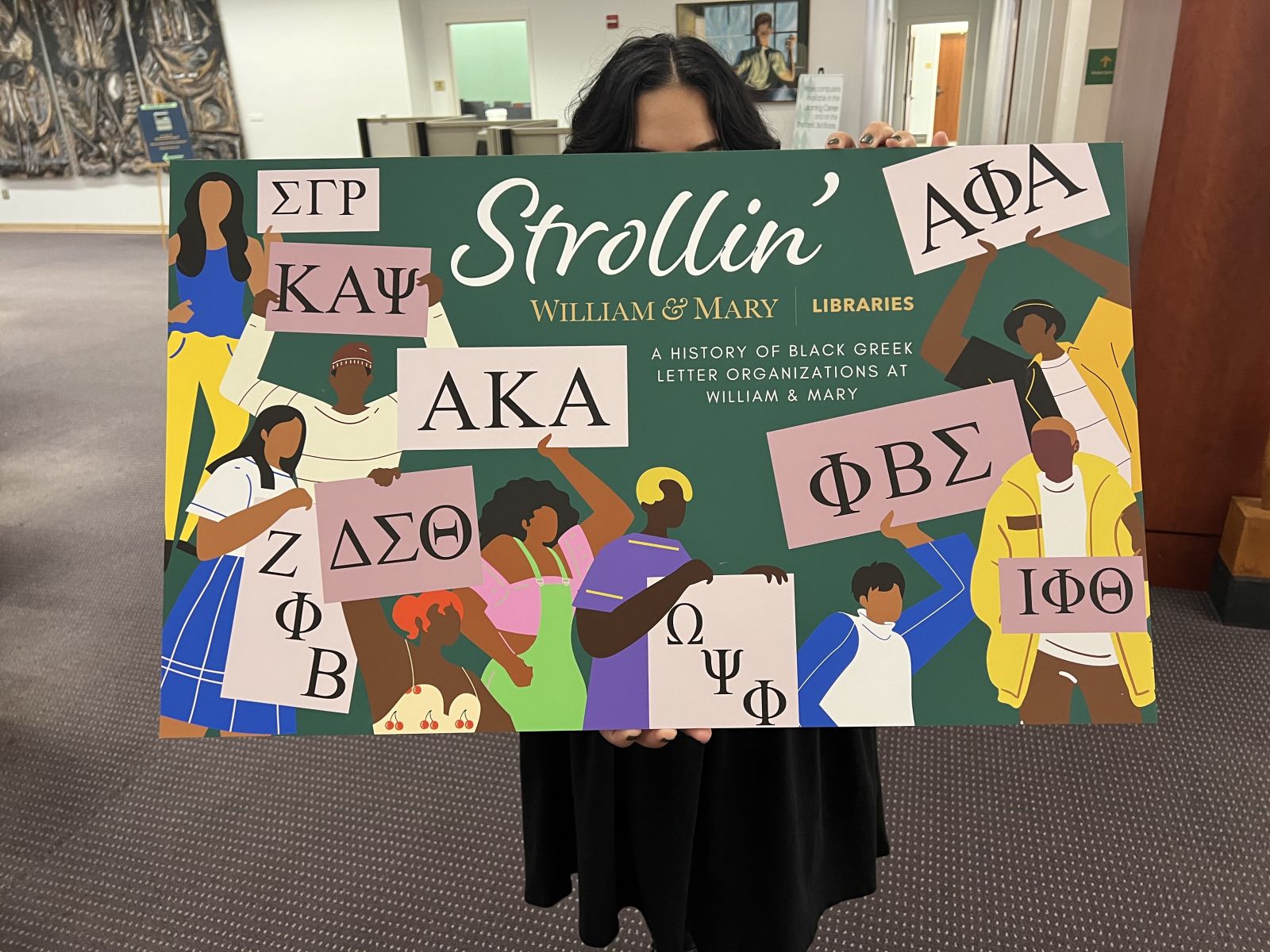Written by Molly Robinson, Graduate Student Apprentice.
* Join us February 1st at 6pm in the Botetourt Gallery for the opening reception, featuring Dr. Gregory Parks.*
 Andre Taylor (right) talks with historian Frederick Murphy about the artifacts used in, Strollin’: A History of Black Greek Letter Organizations at William & Mary.
Andre Taylor (right) talks with historian Frederick Murphy about the artifacts used in, Strollin’: A History of Black Greek Letter Organizations at William & Mary.Strollin’, a new exhibit on view in the Marshall Gallery (1st floor rotunda in Swem Library), brings together belongings from members of Black Greek-letter organizations (BLGOs) at William & Mary. BLGOs have been integral to Black student life on campus. The founding of BLGOs, beginning with Alpha Phi Alpha Fraternity, Inc. at Cornell University in 1906, is inextricable from a broader history of academic institutions in the United States. African Americans were largely excluded from enrolling in predominantly white institutions (PWIs) until the mid-twentieth century. Hulon Willis, Sr. (’56) was the first Black student to enroll at William & Mary in 1951. He was followed by Edward Augustus Travis, the first Black student to graduate from the law school in 1954. Three women—Karen Ely, Lynn Briley, and Janet Brown—became the first Black women and residential students in 1967. They were housed in the basement of Jefferson Hall.[1]
 Librarian Alex Flores holds a poster, which she and Librarian Jessica Ramey designed, advertising a book display for Strollin’, on view in the Marshall Gallery at Special Collections in Swem Library.
Librarian Alex Flores holds a poster, which she and Librarian Jessica Ramey designed, advertising a book display for Strollin’, on view in the Marshall Gallery at Special Collections in Swem Library.I asked Oral Historian and lead curator, Andre Taylor, about what he hopes visitors will take away from Strollin’. Taylor wants visitors to know not only that BLGOs exist at William & Mary, but also how they have existed at the College since the founding of the Kappa Pi chapter of Alpha Phi Alpha in 1975. With the exception of Iota Phi Theta, every organization in the National Pan-Hellenic Council, or Divine Nine, has been represented on campus. While each organization is guided by a unique set of principles, such as good character, scholarship, and perseverance, they share the belief that academic excellence is bolstered by celebrating cultural heritage.
Among the items on display is member apparel, like a purple and gold sweater worn by a member of Omega Psi Phi. Taylor told me that the sweater recalls the pageantry of the Divine Nine. Members wear letter-adorned shirts, sweaters, and jackets to signal affiliation, especially during step performances and in stroll offs. While members may stroll with or without music, the choreographed routines usually engender playful competition between organizations who try to one-up each other through dance. Other items on display include published histories annotated with the names of a member’s line brothers—the men who were part of his member class.
 A banner for Alpha Phi Alpha is unrolled on a table outside of the print shop on the Ground Floor of Swem Library.
A banner for Alpha Phi Alpha is unrolled on a table outside of the print shop on the Ground Floor of Swem Library.A triumph of Strollin’ is its immersive elements. Banners with the names of the Divine Nine hang from columns in Read & Relax, the collective study space outside of Special Collections. These banners appear with QR codes that link visitors to digitally-accessible oral histories given by members of Black Greek-letter organizations at William & Mary. From these oral histories, listeners learn firsthand about the joy, fellowship, and achievement that these organizations have inspired.